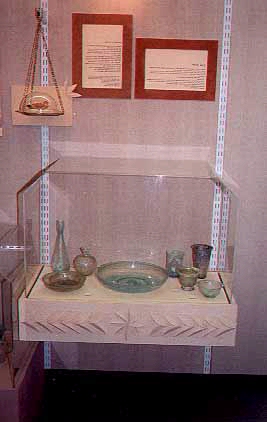News of the Museum - January-February 1997
In this issue:
- About our collection
- The geological corner
- Our current exhibition
- Educational activities
- Lectures on archaeological topics
Restoration of the Agricultural Installations in the Museum Courtyard - These stone implements are part of installations used by ancient man for his agricultural needs. Two oil presses have been restored - a screw press for direct pressure, in use for several years - and now a beam press built with three stone weights. The two presses are in the Museum Courtyard which is also used for other activities and workshops.
The installations will be activated in the coming olive harvest season in October-December 1997.
We intend to hold a Study Day on the subject of the uses of the olive in the past and at the present time, discussing the details of the installation restorations. The precise date and content will be announced. Those interested in taking part are invited to contact us.
The objects appearing in the Exhibition were lent us from the
storerooms of the Antiquities Authorities in Jerusalem. The
photographs were done by Yuval Seeton of the Israel Museum and
by "Shekef", Tel Aviv. In preparing the Exhibition we were
greatly helped by Uza Zebelun's book "Food Vessels in the Time
of the Mishne and the Talmud" and we thank her for the help
thus provided.
The Opening of the Exhibition took place on the White Square in
front of the Museum. The visitors adorned their heads with
floral garlands, inspected the Exhibition and took part in the
various Activities in the spirit of the Roman era, such as the
preparation of jewellery and lapel pins, the weaving of mats
from natural materials and baking bread.
More than 400 people took part in this happening, mainly from
our own region but also tourists passing by.ABOUT OUR COLLECTION
Towards the end of last year the Museum Collection was enlarged by a number of stone objects all from sites in our region. These artifacts were handed over to us by the Antiquities Authority and we received permission to restore the installations for use in our activities.
Restored screw olive press. Photo: Noa Amir.
Base of screw olive press. Photo: Tomer Zelinger.
1996-1217
All rights reserved by courtesy of Israel Antiquities Authority.

Restored lever and weights olive press. Photo: Noa Amir.
Single stone weight for lever and weights olive press. Photo: Tomer Zelinger.
1980-5276
All rights reserved by courtesy of Israel Antiquities Authority.
THE GEOLOGICAL CORNER
This small display is situated at the entrance to the Museum
and its aim is to provide information about the geographical
conditions of the region and their effect on ancient
settlement from earliest times until today. The display as it
was did not seem to us to be sufficiently visitor-friendly,
the geological material being in any case a difficult subject
to present, and the section diagrams were not sufficiently
easy to understand. So we have begun to change the display
which will now illustrate the connection between the rock
formations, the earth and the artifacts.OUR CURRENT EXHIBITION
We opened our new Exhibition "Cornelia's Pantry" in October -
a display of food vessels for storage, cooking and table use.
Cornelia represents the typical woman who lived in Israel in
the Roman Period. We wished to acquaint the visitor with a
section of her material world and those chattels of her
household which she used, from the initial stage of preparing
the food to the actual serving at the table. Using the
viewpoint of the mistress of the home, the visitor becomes
acquainted with various types of artifacts in the typical
kitchen of the Roman Period in Israel, including vessels used
in preparing the food and storing it, clay pots for cooking
and baking, and utensils for the table, both for everyday
(clay) and for festivals (glass).
General view of the exhibition "From Cornelia's Pantry." Photo: Noa Amir.
Detail of the exhibition "From Cornelia's Pantry". Photo: Noa Amir.